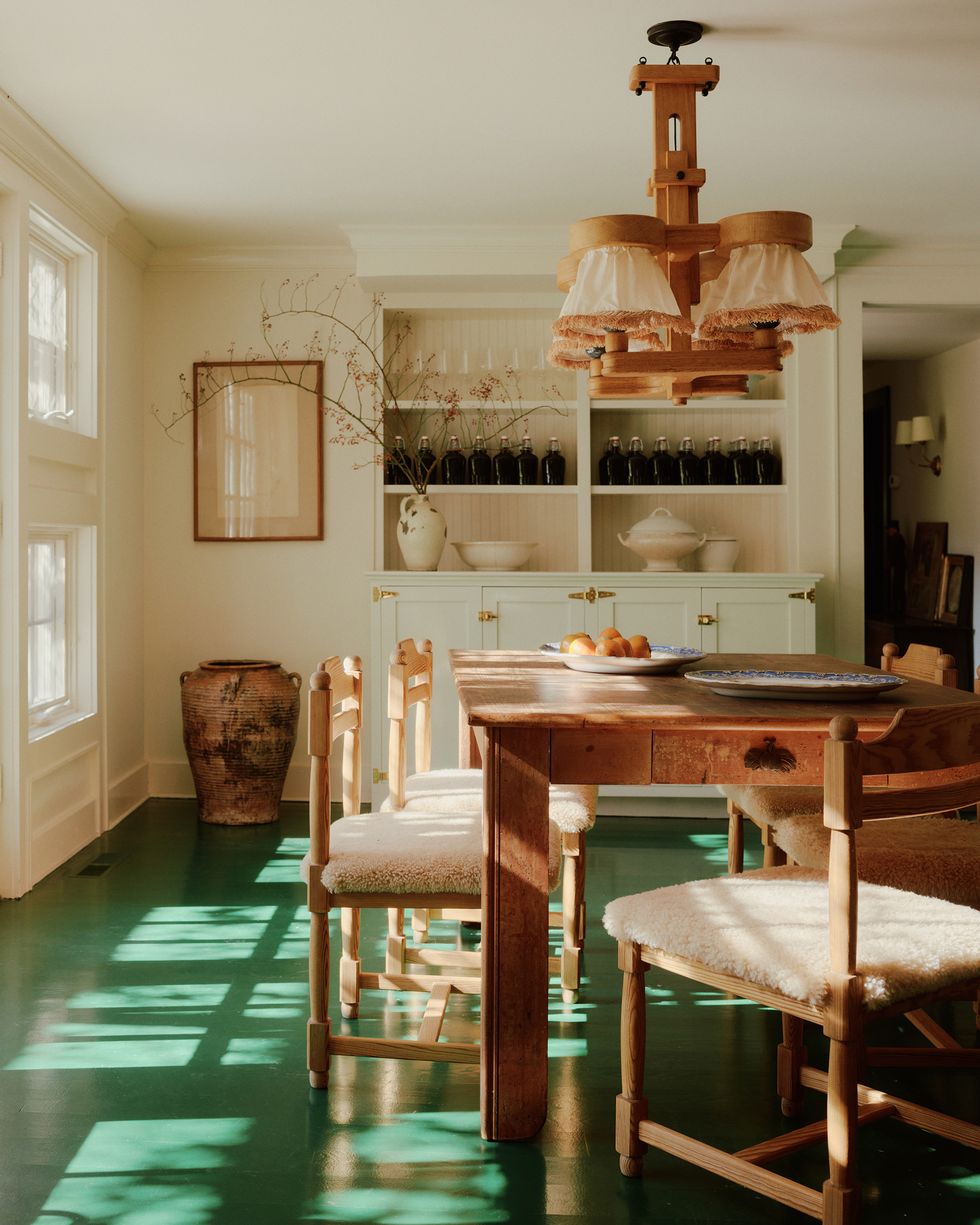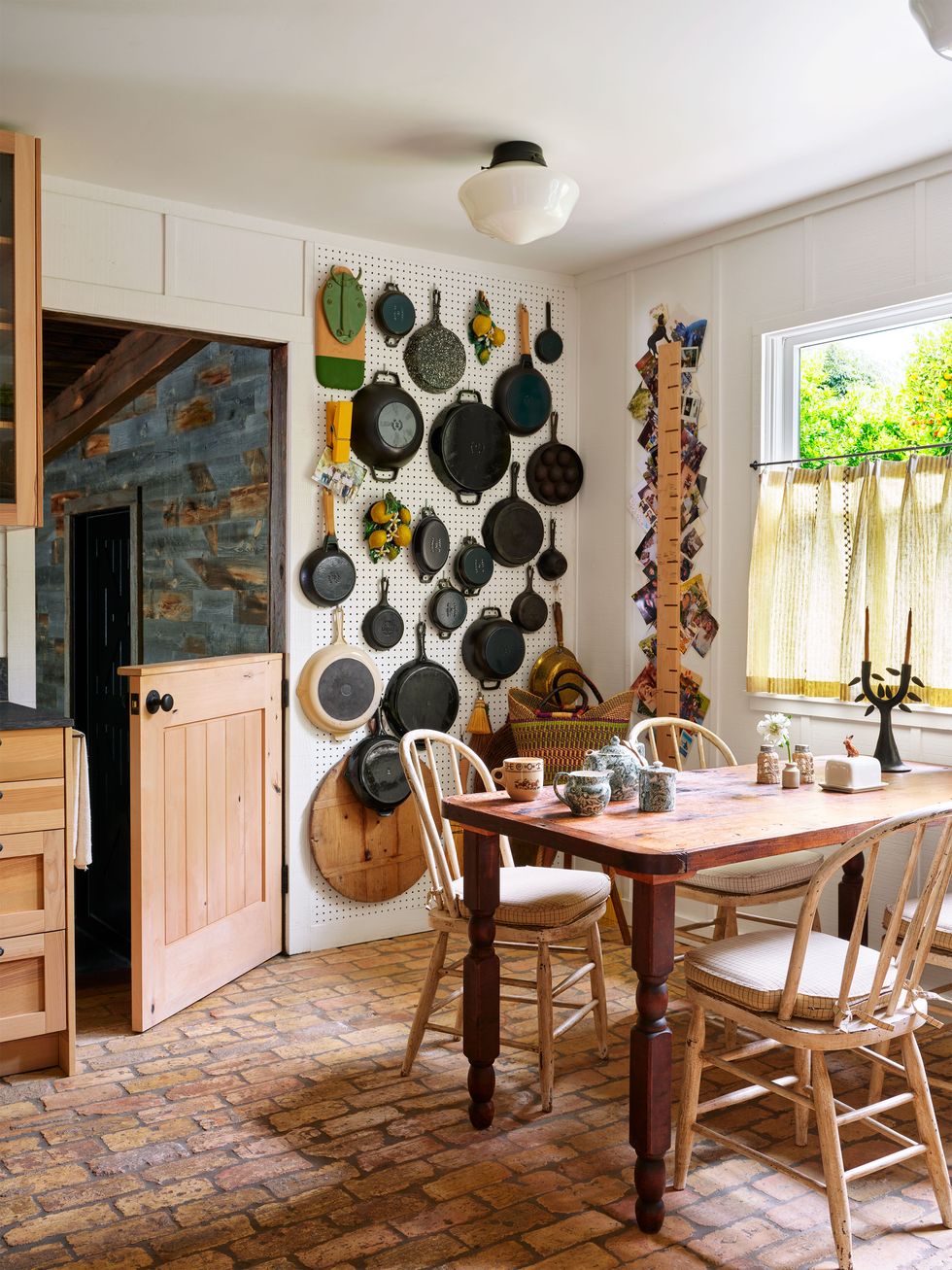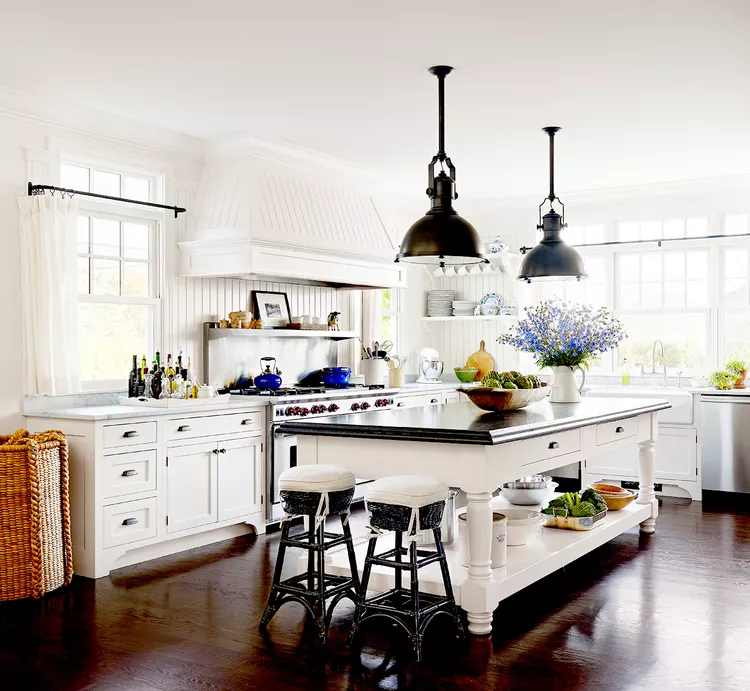Many people love the farmhouse aesthetic for its cozy, welcoming kitchen charm, often highlighted by classic materials like wicker, wood, and linen.
Keep in mind that farmhouse style is diverse: modern farmhouse offers a sleeker, pared-down look; rustic farmhouse emphasizes reclaimed materials; and cottage farmhouse often includes shabby chic touches like florals and patterns.
Whatever your preferred farmhouse flavor, get inspired by the 40 beautiful kitchen ideas below, suitable for any home size or budget, to help you design your dream space.
Modern Farmhouse Kitchen Ideas
:strip_icc():format(webp)/bhg-farmhouse-kitchen-with-color-1TQcw9YeqDZBaWiMw0whKd-06c2569f56614656923e0af6d82392f4.jpg)
There’s something perfectly classic about a white kitchen, but even the crispest, cleanest looking design can benefit from warmer elements.
That can come with the introduction of natural elements like wood, stone, or brick, or from a pop of color that adds an additional layer of personality and interest.
Black and White Farmhouse Kitchen
:strip_icc():format(webp)/bhg-farmhouse-kitchen-with-contrast-DGGhPDH8qNUBf7tl62jcL3-e54b76b5e03f4ef0ba70bd2d719ddfe1.jpg)
To give a modern bend to your farmhouse-style kitchen, find ways to draw out contrasting elements whether materials, color schemes, or design details.
Even subtle plays like black window panes and hardware paired with white cabinets and walls can create a fresh and contemporary look that still brings plenty of warmth.
Small but Mighty Farmhouse Kitchen
:strip_icc():format(webp)/kitchen-blue-cabinets-wooden-countertops-f834a133-1a9c3b1e89c14f8fbbf5aa82eb52d980.jpg)
A small floor plan doesn’t have to hold you back from creating the farmhouse kitchen of your dreams.
This design proves that point with clever tricks that boost the perception of square footage while underscoring the farmhouse aesthetic.
Panel molding draws eyes upward to visually expand the ceiling height, while open shelves take the place of upper cabinetry along one wall to further the sense of spaciousness.
The counter-to-ceiling backsplash features white subway tile—a farmhouse kitchen classic—lined with dark grout to provide texture and a dramatic focal point.
Farmhouse Kitchen Cabinets
:strip_icc():format(webp)/bhg-farmhouse-kitchen-wet-bar-8sp_tX_C4xx8k8EV-UqdvZ-d577945ecd4b43a5a306ef3984634bb5.jpg)
Give your space a fresh perspective by changing your focal point of view.
Look above and below for even more ways to bring farmhouse details to your space.
Rustic ceiling beams, geometric flooring details, and natural materials bring a style and personality that can’t be denied.
Blue Modern Farmhouse Kitchen
:strip_icc():format(webp)/bhg-farmhouse-kitchen-navy-cabinets-7iueX0tAqFJBTrUlgP2J1z-5b719e733a0f4b8283aee1a1101d3388.jpg)
Who says a farmhouse kitchen needs to live in the past?
Here, sleek surfaces and a bold color palette on the cabinetry lend a modern feel.
Natural wood tones bring warmth and give this kitchen a down-to-earth aesthetic.
Rustic Revival
:strip_icc():format(webp)/kitchen-wooden-table-brick-fireplace-cca2963b-abbfa58cb0274c82bb216e660219958f.jpg)
Bring aged-to-perfection style to a new kitchen with a warm blend of natural materials.
Reclaimed white oak ceiling beams span this kitchen’s length, and tumble-edged dark slate tiles lend the floor a time-worn texture.
Carrara marble countertops contrast with vintage-look bronze faucets and hardware that will gather patina over time.
Modern commercial-grade appliances blend seamlessly into the space’s antique charm to balance old and new.
In place of a more traditional island, a large farmhouse kitchen table stands in the center of the room to welcome family gatherings.
Farmhouse Kitchen with Mixed Materials
:strip_icc():format(webp)/bhg-farmhouse-kitchen-with-brick-8-v1dDQ-azJ96y9IAT2YfA-2fe5dec2bd794c7dbec2eacd4a314713.jpg)
Brick, wood, and metal elements are balanced with a large runner that brings warmth and reinforces the kitchen’s color palette.
Playing with materials can bring a unique look and feel to your kitchen with farmhouse details that play up the personality and character of the space.
Farmhouse Kitchen with Open Shelving
:strip_icc():format(webp)/bhg-farmhouse-kitchen-with-stove-6tjMLFnYqS4Al23A78Lzt2-bb002ee8759247e9982b57c2522560ab.jpg)
Skip the cabinets and opt for a statement backsplash that extends all the way up to the ceiling.
Floating shelves provide even more farmhouse-inspired detail while also providing a beautiful way to show off culinary decor items, art, dishware, and more.
Gathering Place
:strip_icc():format(webp)/white-kitchen-island-black-stools-4882a708-eb8c7edf9e2d4da1b0082e28e1a8f303.jpg)
An inviting atmosphere is essential to any farmhouse kitchen.
In this cooking space, which is open to the adjacent dining room, a large island with stool seating beckons friends and family to sit down and stay awhile.
Large grilled windows and open shelving reinforce the expansive feel. Black fixtures and window frames deliver contrast amid white cabinetry and shiplap walls.
White Farmhouse Kitchen Ideas
:strip_icc():format(webp)/bhg-farmhouse-black-and-white-Co8btvU_amh8zSwB9NktyJ-ab3a5f73676c4edfa5695016f70c9d1f.jpg)
Give even the most wide-open of kitchens a cozy and inviting quality by thinking small.
Scaled-down lighting fixtures, unobtrusive shelving, and breezy cafe curtains all add charming detail to this otherwise expansive farmhouse kitchen.
Stylish Farmhouse Kitchen Ideas
:strip_icc():format(webp)/bhg-farmhouse-kitchen-navy-cabinets-EdPVG-YcKhUA1P2eTLbUog-0e3f7a27dfe645db8e5b184f15b79e25.jpg)
Farmhouse kitchens aren’t short on personality, though they may take a more subtle route.
Fluting or beadboard detailing on cabinet fronts can be one way to achieve just that. You can also look to your paint palette for adding interest and depth.
Give your periphery masonry details a more neutral color scheme while adding a splash of color or contrast in the central parts of the kitchen.
Farmhouse Kitchen with Shiplap
:strip_icc():format(webp)/bhg-farmhouse-kitchen-classic-elements-C2k7tp1nKpj9-PGk4sBwg3-11ee094e2652452fa472eefcf5123b5d.jpg)
Shiplap has become synonymous with farmhouse style.
Whether you use it in a small application or swathe your space from floor to ceiling, this is one detail you can never go wrong with.
Play with orientation, width, and other details to give your shiplap a unique-to-you look.
Warm Welcome
:strip_icc():format(webp)/kitchen-blue-cabinets-island-seating-1da82da2-3b3a187676bf446ca8678c649d4197cf.jpg)
Add bold color to wrap a farmhouse kitchen in cozy warmth.
To balance cabinetry painted in a rich royal blue, this kitchen employs reclaimed wood floors and butcher-block countertops—which will both stand up well to wear and tear—to supply natural texture.
Glass-front cabinets put pretty dishes on display, while copper pendant lights deliver shine from above.
The cast-iron range, designed to look like an old-fashioned stove, is topped with a custom zinc hood that will gracefully gain patina with age.
Farmhouse Kitchen with Double Islands
:strip_icc():format(webp)/bhg-farmhouse-kitchen-wooden-cabinets-58ctA9XSazUBmbGkWOFpxy-cac4fad19ba849a991e1c872daa96ed1.jpg)
If you have a larger footprint but still want to lend cozy farmhouse details to your kitchen, consider creating a zoned approach.
Two kitchen islands (one for prepping and dining and the other for cleaning and storage can act as the foundation.
Use architectural elements like ceiling beams, nooks, built-in cabinetry and shelving, and more to carve out your ideal space.
Farmhouse Kitchen Backsplash Ideas
:strip_icc():format(webp)/bhg-farmhouse-kitchen-butcherblock-island-33ddc_wHq_9B2hNJMAZc52-dc1495c4f9d94514b22b6b2fe5999e8f.jpg)
Take your farmhouse-style kitchen up a notch with design details that deliver an elegant feel.
A shiny subway tile backsplash in marble, polished wood countertops, iron chandeliers, and more take classic farmhouse details and elevate them to wow-worthy status.
Colorful Cookery
 William Jess Laird
William Jess Laird
Looking to add a contemporary edge to your farmhouse kitchen?
This modern country home kitchen, designed by Jenna Chused, features unexpected color that brings a youthful energy to the rustic space.
A green painted floor became “one of the best things in the house,” Chused admits.
Cast-Iron Artwork
 Roger Davies
Roger Davies
Sometimes a statement wall is all you need to transform a room.
Designer power couple Eric Hughes and Nathan Turner gave their Los Angeles ranch house kitchen a dash of country charm in the form of a peg rack that holds a collection of cast-iron cookware by Staub.
A vintage table and chairs atop the reclaimed brick flooring is the final touch that merges the farmhouse style with the home’s classic California vibe.
Minimal White Kitchen
 William Waldron
William Waldron
“We really wanted to let the house tell us what to do,” says photographer William Waldron, who leaned into the less-is-more aesthetic in his Hudson Valley farmhouse kitchen.
“Brand-new appliances would look ridiculous,” Waldron explains, noting that the stove that now stands in the kitchen was discovered in a junk pile on the property.
At mealtime, he sets the table with mismatched china and glassware.
Black Kitchen
 Gieves Anderson
Gieves Anderson
Who says you have to follow the typically neutral farmhouse style palette?
This barnlike structure in New York is a perfect fusion of modernism and rustic, with cabinets painted in Farrow & Ball’s Railings. Farmhouse chic at its best.
Pattern Play in the Kitchen
 William Jess Laird
William Jess Laird
This dreamy cottage in Amagansett, New York, is a lovely confluence of gentle colors and tasteful patterns—especially in the kitchen, where a cabinet skirt gives a rustic, gentle touch alongside modern stainless-steel appliances.
Decor items like a copper kettle and cutting board complete the look.
English Country Cottage Kitchen
 John keeble//Getty Images
John keeble//Getty Images
Why merge just two styles?
In this eclectic cottage in Essex, U.K., white painted ceiling beams are paired with colorful cabinets, vintage lighting fixtures, modern appliances, and eye-catching checkerboard floors.
Proof that the right layering can make for charming design symmetry that both surprises and delights—not to mention a chef’s dream when it comes to counter space.
Living Large in a Small Kitchen
 Francesco Lagnese
Francesco Lagnese
To break up the rooms of this cozy Long Island abode, a zinc-topped kitchen island doubles as a countertop and dinner table, complete with a set of Arthur Umanoff stools.
Because farmhouse style is nothing if not hospitable. (Bonus points for the rooster figurine!)
Reclaimed Wood Kitchen
 Bulgac//Getty Images
Bulgac//Getty Images
Nothing garners the charm of country design in a kitchen quite like exposed wood.
In this cozy kitchen, the countertops and rough oak flooring anchor the two-story room, while balancing out the exposed wooden beams.
We especially love the bespoke hanging shelf that displays the hardy wood material so typical of farmhouse decor—and gives off a casual “serve yourself” vibe.
Skirted Kitchen Storage
 William Jess Laird
William Jess Laird
When designing the space just off the kitchen of this modern country home, designer Jenna Chused brought in a calico floral Lisa
Fine print from John Rosselli, which covers the laundry units. This classic farmhouse trope would look equally as lovely beneath a large kitchen sink.
Creative Curations
:max_bytes(150000):strip_icc():format(webp)/Snapinsta.app_356794663_752325216646198_834719314441400080_n_1080-ddba94b0993c4b36987202a33d9ad430.jpg) @havenberryvintage / Instagram
@havenberryvintage / Instagram
Don’t be afraid to go all out with accessories in your farmhouse kitchen.
Get creative when displaying basic items such as spice jars, dish towels, and more. Wooden hooks make it easy to corral like with like.
Farmhouse Kitchen With Cottage-Like Accents
:max_bytes(150000):strip_icc():format(webp)/Snapinsta.app_412470722_1560365264789539_4614644869584554224_n_1080-589534fc0455459b9198d217bbc1801d.jpg) @lauren.ross.design / Instagram
@lauren.ross.design / Instagram
If you appreciate cottage-like touches, weave some florals into your farmhouse kitchen, as seen here with this wallpaper border.
You can also cozy things up a bit more with the addition of a countertop lamp, which will cast a warm glow as you cook.When it comes to appliances, opt primarily for function.
“Make sure the appliance selections meet your modern day needs,” Kimberly Bevan, the founder of Bevan Interiors, says.
“Don’t go overboard on incorporating vintage appliances which look charming but are often not as energy efficient or conducive to today’s kitchen needs.”
Rustic Influence
:max_bytes(150000):strip_icc():format(webp)/Snapinsta.app_400995526_371106358689109_53750652494180436_n_1080-04236c67e7424b788beae69b8234f4d2.jpg) @burlaprosesrevivals / Instagram
@burlaprosesrevivals / Instagram
If your style leans rustic, opt for salvaged-looking furniture pieces like this wooden cabinet.
“Traditionally, farmhouses would use the materials readily available on their land to create the kitchen which might include old barn wood or wood from fallen trees,” Bevan explains.
Other wooden features commonly used in farmhouse kitchens include butcher blocks, painted or stained solid wood cabinetry, and reclaimed wooden beams.
You can also repurpose vintage glass jars and use them to store essential ingredients in the cabinet and on your countertop.
Beadboard Walls in Farmhouse Kitchen
:max_bytes(150000):strip_icc():format(webp)/Snapinsta.app_434558853_18099604912395603_5815105569281441865_n_1080-7a47facdff6b4ff58aac26b9a933a988.jpg) @livesimplymodernfarmhouse / Instagram
@livesimplymodernfarmhouse / Instagram
Jazz up simple kitchen walls with the addition of beadboard, a material that is often found in farmhouse style homes.
It looks nice painted in the color of your choosing or left plain white. Alternatively, opt for a two-toned look as seen here!
Handy Plate Rack
:max_bytes(150000):strip_icc():format(webp)/Snapinsta.app_327562232_1251333275741297_8599299891107268315_n_1080-750ec63d6942467baea8a67a69e364c5.jpg) @mels_home_and_garden / Instagram
@mels_home_and_garden / Instagram
Use a plate rack to display your favorite dishes in the kitchen.
Accessing and putting away your servingware has never been easier, either.
Farmhouse Kitchen With Sweet Skirted Sink
:max_bytes(150000):strip_icc():format(webp)/Snapinsta.app_405529914_18405147562049746_940642420613064097_n_1080-087f287977df496685689baaf687a5c8.jpg) @tracey_hiebert / Instagram
@tracey_hiebert / Instagram
Instead of opting for traditional wooden doors, consider placing skirted fabric over your sink to conceal what’s underneath while adding a touch of charm to the kitchen.
You can easily DIY your own skirt using leftover fabric that you already have on hand.
Wooden Hooks on the Wall
:max_bytes(150000):strip_icc():format(webp)/Snapinsta.app_335696402_747354543781211_4559291473844295998_n_1080-2d2b19637d08476ab7a9f594ecf1c080.jpg) @theredheadedfarmgirl / Instagram
@theredheadedfarmgirl / Instagram
Short on storage space? No problem!
Make use of a wooden hook system on the wall and use it to house everything from dishcloths to decor.
Farmhouse Kitchen With Neutral Components
:max_bytes(150000):strip_icc():format(webp)/Snapinsta.app_409060396_436894978677980_5559748982642072142_n_1080-642e7bae39c84f508a3e4101b4837868.jpg) @farmgirl2be / Instagram
@farmgirl2be / Instagram
Many farmhouse kitchens are neutral in color, but that doesn’t mean you can’t go all in with various tones and textures.
Weave in touches of wood, wicker, copper, and metal to create a collected look.
You can likely shop your house first to find items that might look nice displayed in the kitchen prior to purchasing anything new.
Open Shelving All Over
:max_bytes(150000):strip_icc():format(webp)/Snapinsta.app_67028564_2308820499335195_6465434093767329862_n_1080-9f9b9246101e4bf798526d6dbaee36a8.jpg) @simplyminedesigns / Instagram
@simplyminedesigns / Instagram
Wooden open shelving is another farmhouse kitchen fixture. Style yours with a mixture of decorative and practical objects.
Versatile Side Cart
:max_bytes(150000):strip_icc():format(webp)/Snapinsta.app_355812097_598896725685732_8926225897216519966_n_1080-e3c01dad37fe413b86596495530f067c.jpg) @sweetcottagecharm / Instagram
@sweetcottagecharm / Instagram
Turn a side cart into a cute display in the kitchen by outfitting it with some of your favorite items, such as cookbooks and platters.
When you’re entertaining, you can clear off the top and use it to serve food.
Farmhouse Kitchen With Dazzling Wooden Beams
:max_bytes(150000):strip_icc():format(webp)/Snapinsta.app_380817300_800213905442483_623066765857983763_n_1080-fed296b59ab94f94b57adf9450310957.jpg) @pineandprospecthome / Instagram
@pineandprospecthome / Instagram
If your kitchen features exposed wooden beams, let them be the star of the show by leaving them in their natural state, which will help you fully embrace the classic farmhouse look.
Cutting Board Display
:max_bytes(150000):strip_icc():format(webp)/Snapinsta.app_441565018_366675865929730_5107321815954411207_n_1080-a7fd23c6623e4948ad05d23eb2dfc9c0.jpg) @thebloomingedit / Instagram
@thebloomingedit / Instagram
Rather than storing your wooden cutting boards behind closed doors, take them out and lean them against your backsplash so that they double as decor.
Wooden accents are a key component of farmhouse style kitchens, and being that cutting boards are so affordable and utilitarian, they’re a no-brainer purchase.
Painted Farmhouse Style Hutch
:max_bytes(150000):strip_icc():format(webp)/Snapinsta.app_438100260_18432101092013678_5169995387618658410_n_1080-25a010ce56bf4aa599f6860e143016ad.jpg) @athomewithmelmel / Instagram
@athomewithmelmel / Instagram
Bring some cottage flair into your farmhouse kitchen with the addition of a painted hutch.
It’s a useful alternative to traditional cabinetry, and you can paint yours in the color of your choosing.
This light sage green is a hue that many people who choose to bring color into their farmhouse kitchen tend to use.
Ready to Host
:max_bytes(150000):strip_icc():format(webp)/Snapinsta.app_272101767_928596324508830_7585732814286649782_n_1080-648bf8cbf16c4633aea3cdb9eae1fea1.jpg) @heartofwendy / Instagram
@heartofwendy / Instagram
Farmhouse kitchens are always the perfect place to host a gathering of family and friends.
Equip yourself to host the whole crew by setting up a sweet coffee bar that’s fully stocked with mugs and more.
Farmhouse Kitchen With Fresh Flowers
:max_bytes(150000):strip_icc():format(webp)/Snapinsta.app_381338981_3558301534431653_6104025552262753328_n_1080-e836a5050f834ca1a348c19dbfed0c71.jpg) @candlewoodcottage / Instagram
@candlewoodcottage / Instagram
No farmhouse kitchen is complete without some flowers.
Whether you trim some from your garden or head down to the local farm stand, you won’t want to forgo a vessel filled with beautiful blooms.
Dried hydrangeas look beautiful as well and will last for many months on end with no maintenance required.


